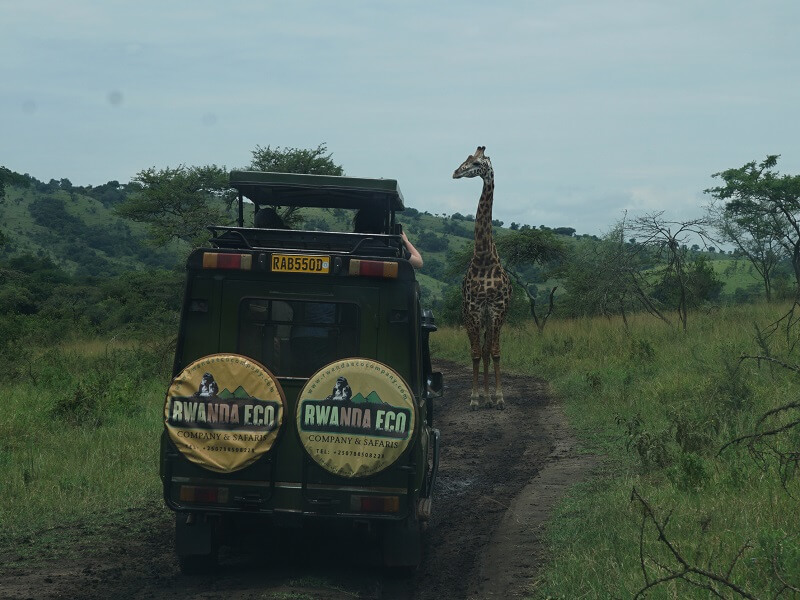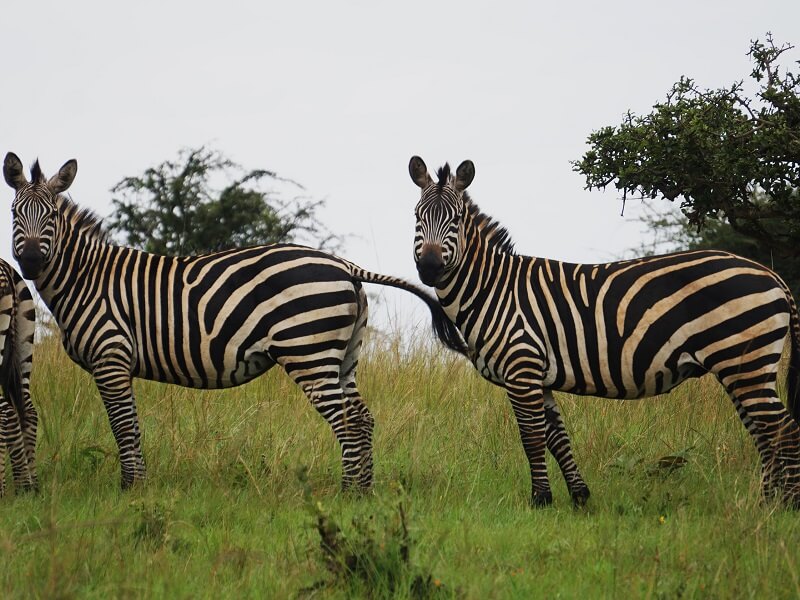About Akagera National Park, Rwanda’s only savannah type national park, located in the northeast of Rwanda along the border with Tanzania, roughly about the hour’s drive from Kigali. Akagera National Park covers about 1,120km² and is one of Africa’s oldest national parks, first gazette in 1934. Akagera national park is the only Savannah Park in Rwanda and is home to several mammal species including Lions, Elephants, Giraffes, Hippos, Kobs, Zebras, Bushbucks, Waterbucks and most recently Black Rhinos have been introducing from South Africa, making Akagera national park officially a big 5 park like it was many years ago.
It is also home to numerous bird species in the several habitats which include woodland, swamps, lakes and Savannah. It is named after the Akagera River that flows along its eastern boundary and feeds into a labyrinth of lakes of which the largest is Lake Ihema. The forest fringed lakes, papyrus swamps, savannah plains and rolling highlands combine to make Akagera amongst the most scenic of reserves anywhere in Africa. It has exceptional levels of biodiversity and forms the largest protected wetland in central Africa. The north of Akagera is mostly fairly low-lying grasslands and savannah plains, similar in feel to the ‘traditional’ safari areas of East Africa. To the west are rolling hills and valleys more typical of Rwandan countryside while to the east, the Akagera River feeds into a series of lakes, marshes and papyrus swamps that constitute central and eastern Africa’s largest protected wetlands. So, for a fairly small National Park, an Akagera safari can be extremely diverse with a variety of habitats, wildlife and birds, and some lovely scenery. Although founded in 1934, much of the park was re-allocated as farms and in 1997 the park was reduced in size from more than 2,500 sq km (nearly 10% of the surface area of Rwanda) to its current extent of 1,122 sq km. Since 2010, a joint venture with African Parks has seen Akagera return to its former glories and once again is shining and harboring all the big 5 mammals that has greatly improved the wildlife safaris and tourism in Rwanda. Akagera is almost unrecognizable today compared to just 20 years ago when it was on the verge of being lost forever. While peace was finally restored in the 1990s after the Rwandan Civil War, Akagera’s demise was just beginning. However, strict conservation laws, better management, the reintroduction of lions in 2015 and black rhinos in 2017, the revamping of old camps and the building of new ones has meant that Akagera is getting increasingly popular.
The north of Akagera is mostly fairly low-lying grasslands and savannah plains, similar in feel to the ‘traditional’ safari areas of East Africa. To the west are rolling hills and valleys more typical of Rwandan countryside while to the east, the Akagera River feeds into a series of lakes, marshes and papyrus swamps that constitute central and eastern Africa’s largest protected wetlands. So, for a fairly small National Park, an Akagera safari can be extremely diverse with a variety of habitats, wildlife and birds, and some lovely scenery. Although founded in 1934, much of the park was re-allocated as farms and in 1997 the park was reduced in size from more than 2,500 sq km (nearly 10% of the surface area of Rwanda) to its current extent of 1,122 sq km. Since 2010, a joint venture with African Parks has seen Akagera return to its former glories and once again is shining and harboring all the big 5 mammals that has greatly improved the wildlife safaris and tourism in Rwanda. Akagera is almost unrecognizable today compared to just 20 years ago when it was on the verge of being lost forever. While peace was finally restored in the 1990s after the Rwandan Civil War, Akagera’s demise was just beginning. However, strict conservation laws, better management, the reintroduction of lions in 2015 and black rhinos in 2017, the revamping of old camps and the building of new ones has meant that Akagera is getting increasingly popular.
Refugees returning to Rwanda after the genocide were still battling for their own survival and turned to the forests for timber, wildlife for protein and the wild savannahs for their livestock. Lions were hunted to local extinction, rhinos disappeared, and the park’s wildlife was displaced by tens of thousands of long-horned cattle. Biodiversity was practically lost, and with it so was employment and tourism. The park’s value was diminished to the point of not existing at all. Which makes where Akagera is today, with its story of revival, even more remarkable.
In 2010, African Parks assumed management of Akagera in partnership with the Rwanda Development Board (RDB), shifting the park’s trajectory from one of oblivion to prosperity and hope. After years of preparation, through effective law enforcement and management, 2017 saw the historic return of 18 Eastern black rhinoceros after a 10-year absence, thanks to the support from the Howard G. Buffett Foundation. Two new male lions were also translocated to Akagera in 2017 to enhance the genetic diversity of the growing pride, which has now tripled since their reintroduction in 2015. With poaching essentially halted, the park’s key wildlife populations have continued to rise. More than 37,000 tourists visited the park in 2017 alone, half of whom were Rwandan nationals, bringing in a record US$1.6 million in revenue and making the park 75% self-sustaining in just seven years.
 Akagera combines well with Nyungwe National Park, which is known for the nature walk, canopy walk and chimpanzee tracking and the Volcanoes National Park for its golden monkeys and gorillas to offer a great safari element as it is home to many large plains game species as well as species restricted to the papyrus swamps such as the Sitatunga and the sought-after Shoebill Stork. Notable plains game includes elephant, buffalo, Topi, zebra, waterbuck, roan antelope and eland. Other antelope are duiker, oribi, bohor reedbuck, klipspringer, bushbuck and impala. Of the primates, olive baboons, velvets and the secretive blue monkey are seen during the day, with bush babies often seen on night drives. Buffaloes slightly increase to 2567 units from 2093 units in the period under review, but in the previous census, they were below 1000 units.
Akagera combines well with Nyungwe National Park, which is known for the nature walk, canopy walk and chimpanzee tracking and the Volcanoes National Park for its golden monkeys and gorillas to offer a great safari element as it is home to many large plains game species as well as species restricted to the papyrus swamps such as the Sitatunga and the sought-after Shoebill Stork. Notable plains game includes elephant, buffalo, Topi, zebra, waterbuck, roan antelope and eland. Other antelope are duiker, oribi, bohor reedbuck, klipspringer, bushbuck and impala. Of the primates, olive baboons, velvets and the secretive blue monkey are seen during the day, with bush babies often seen on night drives. Buffaloes slightly increase to 2567 units from 2093 units in the period under review, but in the previous census, they were below 1000 units.
For the Lions introduced in the park only last year have already doubled from 7 to 15 currently, despite one loss of an adult lioness. Other animals the census covered include giraffes, eland, roan, Waterbucks, Zebras, Topi, Moreover, the population of roan antelope, a specie that in 2002 was feared nearing its extinction is rather recovering. Impala, Warthog and Hippopotamus. Of all these animals, the Buffalos, Waterbucks, Zebras, Topi and Warthogs have greatly increased compared to their population in the period 2010-2013 Due to its wide variety of habitats, Akagera is an important ornithological site with nearly 500 bird species. The rare and elusive shoebill shares the papyrus with other rarities such as the exquisite papyrus gonolek and countless other water birds that inhabit the wetlands in large numbers.
